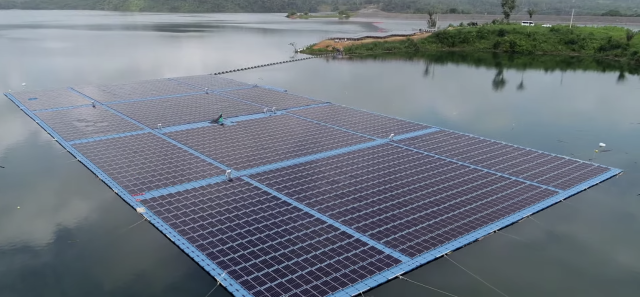
Noria Energy’s Aquasol 1.5 MW pilot floating solar project in Córdoba, Colombia. (Source: Noria Energy)
California-based Noria Energy launched a new 1.5-megawatt (MW) pilot floating solar power system on the reservoir at Colombia's Urrá Dam, the largest such project of its kind in South America.
Called Aquasol—a combination of the words ‘water’ and ‘sun’ in Spanish—was installed at the 340-MW Urrá hydropower plant in the Sinú River basin in Córdoba, Colombia, according to a June 22 Noria press release.
The project consists of over 2,800 solar modules and will produce nearly 2,400 megawatt-hours of power in its first year — enough to offset the amount of energy it takes to operate the dam, Noria said.
Noria, with partners 1Solution, DISICO SA, G&C, Isigenere and Seaflex, designed, developed and installed the floating photovoltaic system for the independent power producer URRÁ SA ESP.
“Aquasol is expected to avoid more than 1,540 tons of carbon dioxide emissions every year, and generate over $1.2 million in additional electric power revenue over 20 years,” according to Noria.
Hydroelectric dams and solar energy
Colombia’s Urra hydroelectric dam is one of the largest in Colombia, holding back 1.6 Bcm of water, according to Noria. The company’s push to diversify its energy generation potential led it to explore synergies from combining floating solar with hydroelectric reservoir resources.
The aim of Aquasol is to “demonstrate that hydroelectric dams dealing with fluctuating water levels can pair with floating solar generation to boost energy reliability and increase production,” Noria said in the release.
With the floating solar, the “surrounding water allows for cooler more consistent temperatures, increasing operating efficiency by 10%-15%, and these systems have numerous water quality benefits that increase the value of the body of water,” according to Noria’s website.
Noria plans to collect and compare data from Aquasol's production and efficiency to that of a ground-mounted solar system located onshore. The data will be used to design and model larger-scale systems to maximize the generation potential of floating solar and hydroelectric dams, Noria said.
“Worldwide, around 60% of renewable energy comes from hydropower. That represents countless opportunities to deploy floating solar that can maximize zero-emission energy generation and diversify clean energy sources,” Noria CEO Jonathan Wank said in the release.
Besides boosting the total generating capacity of hydroelectric dams, Noria's floating solar systems can also assist to keep energy flowing when low water levels or other adverse conditions reduce hydroelectric output, the U.S.-based company said.
Noria’s floating solar system has been designed to sit on top of the water and withstand fluctuating water levels of up to 120 ft.
Placing solar facilities on water also avoids land-use conflicts, and pairing them with dams “takes advantage of existing interconnection and other energy infrastructure,” Noria said.
Recommended Reading
SilverBow Resets Shareholder Meeting After $2.1B Crescent Deal
2024-05-16 - SilverBow Resources said it will adjourn its May 21 shareholders’ meeting until May 29 following Crescent Energy’s agreement to buy the Eagle Ford operator.
Blue Racer Midstream Prices Senior Notes Offering
2024-05-15 - Net proceeds from the sale of senior notes will be used to pay off debt and other general corporate purposes.
Petrobras CEO Prates to Step Down
2024-05-15 - Brazil’s President Luiz Inácio Lula da Silva has requested that Petrobras CEO Jean Paul Prates resign following a dispute over dividend payments.
Pembina Pipeline to Renew Share Repurchase Program
2024-05-14 - Pembina Pipeline has approval from the Toronto Stock Exchange to purchase up to 5% of its outstanding common shares.
ProPetro Adds Exxon Designee Volkov to Board
2024-05-14 - Alex Volkov is currently the transition executive tasked with planning the integration of Pioneer Natural Resources and Exxon Mobil.






